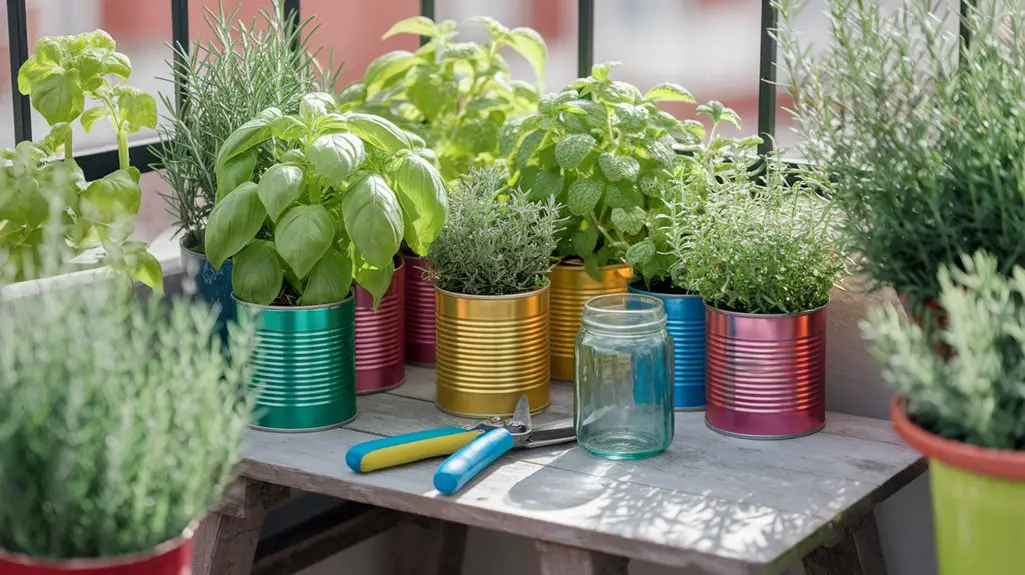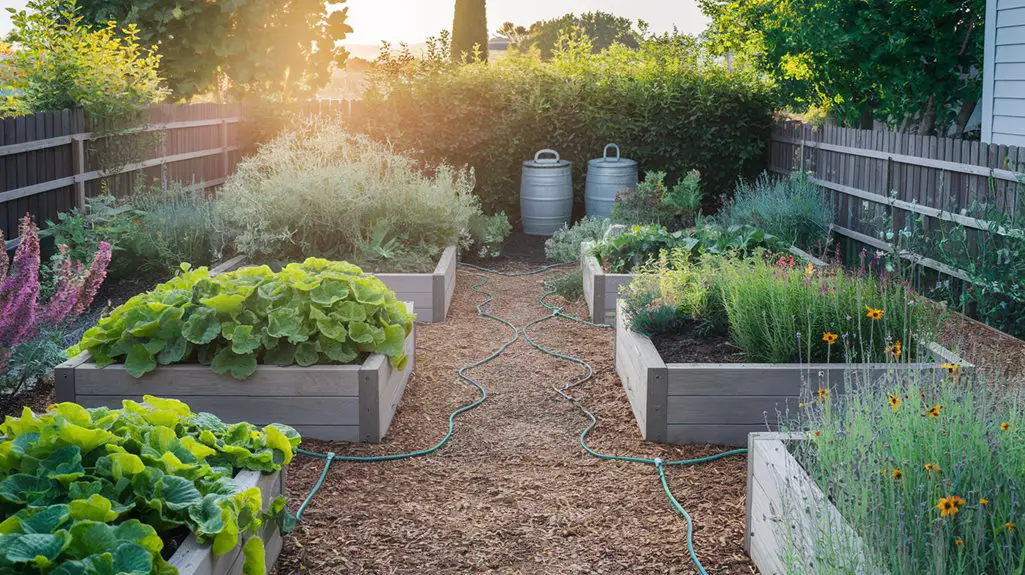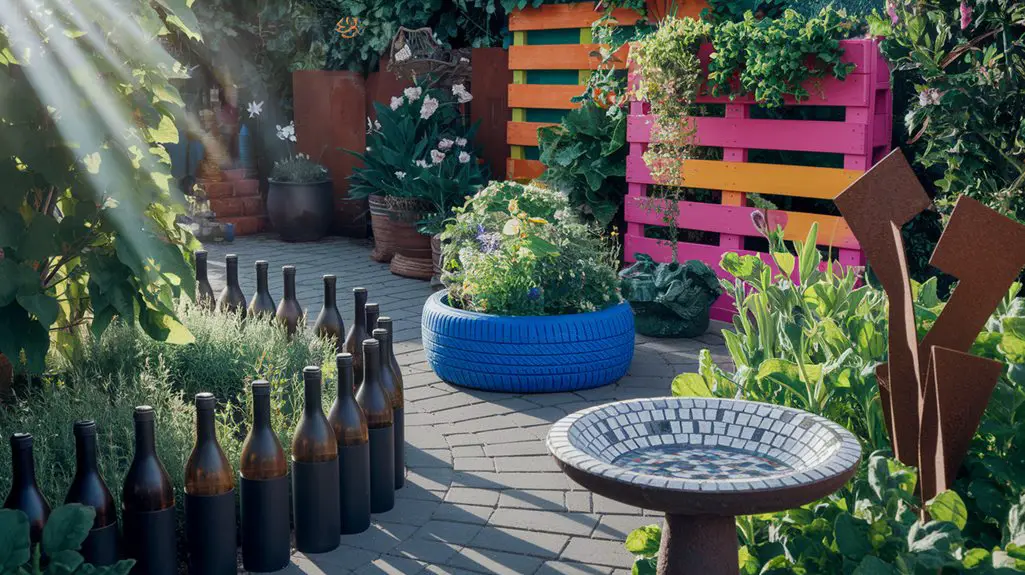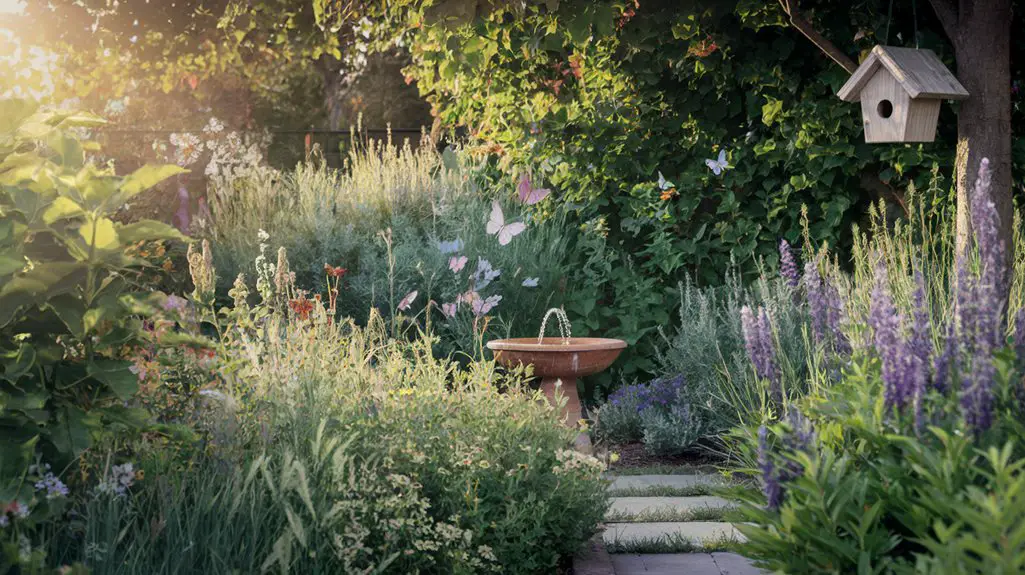If your garden budget has seen better days, you're not alone in seeking economical ways to grow your own herbs. You'll find that establishing a productive herb garden doesn't have to drain your wallet. Start with seeds instead of starter plants, mix your own soil using compost and affordable amendments, and repurpose household items as planters. These initial steps will greatly reduce your setup costs while ensuring bountiful harvests. What other money-saving techniques can transform your herb gardening experience?
Starting an Herb Garden With Seeds vs. Plants: Cost Comparison
When considering the economics of home herb gardening, the choice between seeds and starter plants represents a significant cost variable.
Seeds typically cost $1-3 per packet containing dozens or even hundreds of potential plants, offering exceptional value compared to nursery seedlings priced at $3-5 each.
You'll find that seeds require additional investments in growing medium, containers, and time (2-8 weeks longer), while starter plants provide immediate results.
Annual herbs like basil, cilantro, and dill demonstrate the greatest cost savings from seed, while perennial varieties such as rosemary, thyme, and sage—with their slower germination rates and lengthy establishment periods—may justify the higher initial investment in established plants.
Calculate your break-even point by factoring in your climate zone, available growing season, and intended harvest volume. Additionally, incorporating beneficial insects can enhance your herb garden's productivity, making it even more worthwhile to start from seeds.
Repurposed Containers for Growing Budget-Friendly Herbs
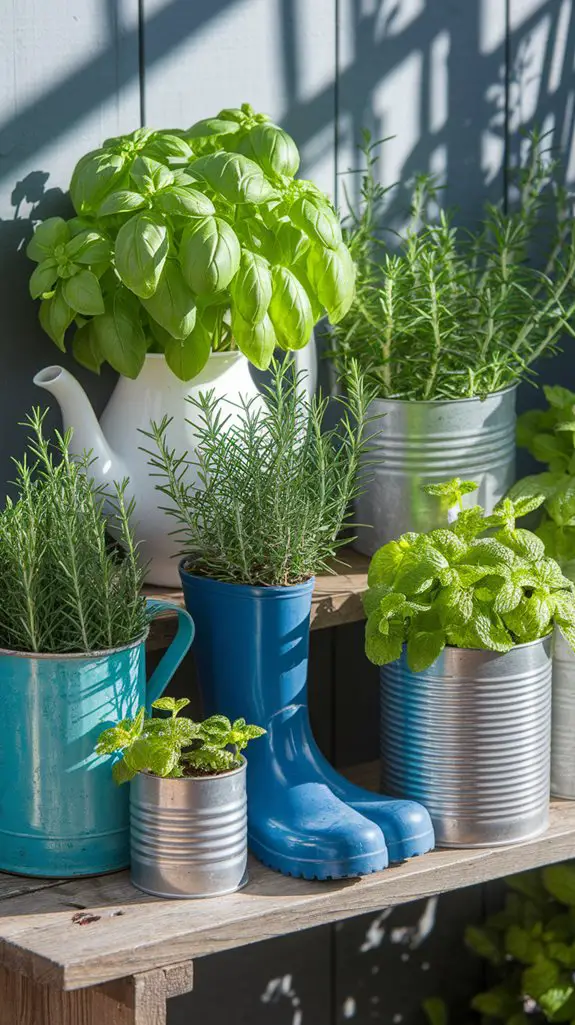
Repurposing household items into functional herb planters: yogurt containers (drill drainage holes), mason jars, tin cans, wooden crates, and milk jugs cut horizontally. Each vessel requires proper drainage to prevent root rot. For best results, match containers to specific herbs' requirements. Shallow-rooted varieties like thyme and chives thrive in repurposed baking pans, while deeper-rooted basil and rosemary require coffee tins or cut 2-liter bottles. Sanitize all containers with a 1:10 bleach solution before planting to eliminate pathogens. Additionally, consider using small herb garden ideas that maximize your growing space and enhance the aesthetic appeal of your apartment. Stack vertical container systems using plastic bottles or hanging shoe organizers to maximize growing space in confined areas. This technique increases yield without expanding your garden's footprint.
DIY Potting Soil Mixes for Herb Gardens
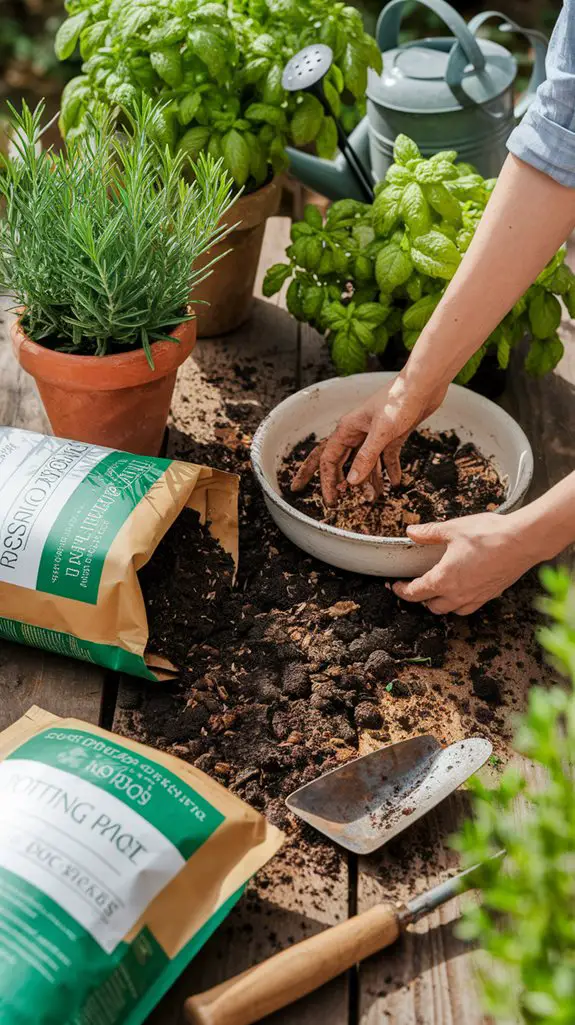
Commercial potting soil represents three to four times the cost of homemade alternatives, making DIY soil mixes an essential strategy for budget herb gardeners. You'll enhance your herbs' growth while cutting expenses by crafting custom blends tailored to specific herb requirements. Edible landscaping ideas, particularly those incorporating herb gardens, can further optimize your garden space.
| Component | Proportion | Function | Cost | Source |
|---|---|---|---|---|
| Compost | 40-50% | Nutrients | Low | Homemade |
| Coco coir | 20-30% | Water retention | Medium | Garden centers |
| Perlite | 10-20% | Drainage | Medium | Bulk suppliers |
| Vermiculite | 5-10% | Aeration | Medium | Hardware stores |
| Worm castings | 5-10% | Micronutrients | Low-Medium | DIY bins |
Mix these components in a large container using a 1:1:1 ratio for Mediterranean herbs like rosemary and thyme. For moisture-loving herbs such as mint and basil, increase the coir proportion to 40%.
Vertical Herb Garden Solutions for Small Spaces
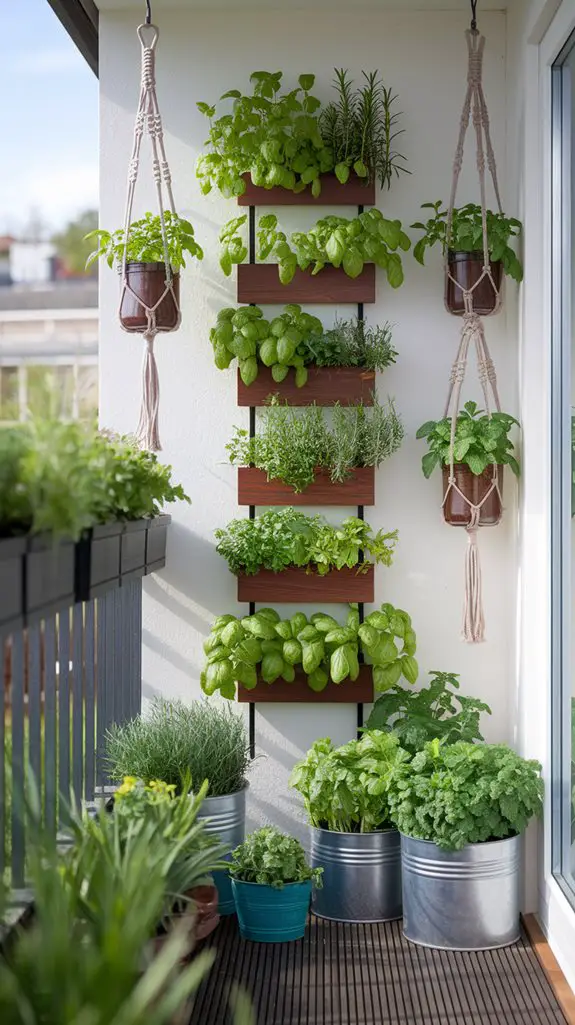
Growing upward rather than outward maximizes your herb-growing potential in limited areas, making vertical gardening a practical solution for apartment dwellers and urban gardeners.
Implement wall-mounted pocket organizers, repurposed pallets, or stackable containers to establish efficient growing systems. These structures require minimal floor space while accommodating multiple herb varieties.
For best results, position your vertical garden to guarantee adequate light exposure—south-facing installations typically receive maximum sunlight.
Install a drip irrigation system with a timer to deliver consistent moisture without wastage. Select herbs based on their vertical compatibility: cascading varieties like thyme and oregano work well in upper sections, while compact plants such as chives and parsley thrive in lower positions.
When mounting, verify wall weight capacity and install proper drainage to prevent structural damage from excess moisture. Additionally, consider incorporating creative herb garden ideas that enhance both aesthetics and functionality in your vertical setup.
Water-Saving Techniques for Economical Herb Growing

Water conservation stands at the core of any economical herb garden, with strategic techniques greatly reducing both utility costs and environmental impact. Implement drip irrigation systems to deliver water directly to root zones, minimizing evaporation waste by up to 60%. Collect rainwater in barrels fitted with mesh filters to prevent debris contamination and mosquito breeding. Additionally, incorporating sustainable gardening practices can further enhance the efficiency and productivity of your herb garden.
| Technique | Water Savings | Implementation Cost | ROI Timeline |
|---|---|---|---|
| Drip System | 50-70% | $20-40 | 3-6 months |
| Rainwater Harvesting | 40-100% | $35-100 | 6-12 months |
| Mulching | 20-30% | $5-15 | 1-2 months |
| Grouping by Water Needs | 15-25% | $0 | Immediate |
Apply 2-3 inches of organic mulch around herbs to retain soil moisture while suppressing weed competition. Group plants with similar hydration requirements together, ensuring efficient watering cycles without risking under or overwatering.
Propagating Herbs From Cuttings and Divisions
For savvy gardeners seeking to maximize their herb collections without depleting their wallets, propagation through cuttings and divisions represents the most cost-effective multiplication method available.
Soft-stemmed herbs like basil, mint, and oregano readily root from 4-inch stem cuttings placed in water or moist soil. Remove lower leaves, dip cut ends in rooting hormone, and maintain high humidity for ideal results.
Woody herbs such as rosemary and thyme require semi-hardwood cuttings taken in early fall.
For clumping perennials like chives and lemon balm, division proves most effective—simply dig up the parent plant, separate the root mass into sections using a sharp knife, and replant immediately.
Each division retains the exact genetic characteristics of the parent, ensuring consistent flavor profiles in your expanded collection. Additionally, many herbs thrive in raised bed gardens, providing optimal drainage and soil quality for healthy growth.
Year-Round Indoor Herb Growing to Maximize Value
To maximize your investment in herb gardening, consider establishing an indoor growing station that operates year-round, eliminating seasonal limitations while guaranteeing continuous fresh harvests. Position herbs near south-facing windows for ideal light exposure or invest in affordable LED grow lights that consume minimal electricity while providing full-spectrum illumination. Additionally, incorporating creative indoor herb garden ideas can further enhance your growing experience.
| Herb Type | Light Requirements | Ideal Indoor Temperature |
|---|---|---|
| Basil | 6-8 hours direct | 65-75°F (18-24°C) |
| Rosemary | 6+ hours direct | 55-70°F (13-21°C) |
| Mint | 4-6 hours indirect | 55-70°F (13-21°C) |
Rotate containers weekly to guarantee uniform growth and implement a quarterly repotting schedule using recycled containers. Monitor humidity levels closely, as indoor heating systems often create excessively dry conditions that compromise herb health. This systematic approach guarantees continuous herb availability at a fraction of grocery store prices.
Companion Planting Strategies for Healthier Herbs
Strategic pairing of compatible herbs and vegetables greatly enhances growth rates while reducing pest pressures without chemical interventions.
Basil thrives alongside tomatoes, deterring flies and mosquitoes while improving flavor yields. Plant rosemary near carrots to repel carrot flies, and sage beside cabbage to ward off cabbage moths.
Chives protect against aphids when grown with roses or tomatoes, while chamomile improves essential oil content in nearby herbs. For space efficiency, interplant trailing thyme with upright dill or fennel.
Avoid growing fennel near most herbs—it inhibits growth through allelopathic compounds.
Create beneficial microclimates by positioning tall herbs like rosemary to shelter tender varieties from harsh afternoon sun. Additionally, employing natural pest management techniques can further enhance your garden's health and productivity.
These natural synergies minimize pest control costs while maximizing nutrient uptake, yielding a more productive garden without additional expenditure.
Natural Pest Control Solutions for Herb Gardens
Maintaining a thriving herb garden doesn't require expensive chemical treatments when common household ingredients can effectively deter or eliminate most pest problems. Natural solutions disrupt pest lifecycles while preserving beneficial insects and your herbs' integrity.
Implement these cost-effective remedies:
- Create garlic spray by steeping crushed cloves overnight in water, then adding a drop of biodegradable soap—lethal to aphids and spider mites.
- Sprinkle diatomaceous earth around plant bases to dehydrate slugs, snails, and crawling insects through microscopic abrasions.
- Deploy vinegar-water solutions (1:3 ratio) against powdery mildew and fungal infections.
- Introduce companion plants like marigolds and nasturtiums that repel nematodes and whiteflies while attracting predatory insects.
In addition, natural pest control methods such as using insecticidal soap can provide an extra layer of protection against soft-bodied pests. Apply these treatments during early morning hours when beneficial insects are less active, maximizing effectiveness while minimizing collateral impact.
Harvesting and Preserving Herbs for Maximum Return on Investment
The proper harvesting and preservation of herbs establishes the foundation for maximizing your garden's economic value. Harvest during mid-morning after dew has evaporated but before the sun's heat depletes essential oils. You'll achieve peak flavor by cutting just before flowering occurs. Engaging kids in an herb garden can enhance their learning experience by teaching them about plant growth cycles and the importance of herbs in cooking and medicine.
| Herb Type | Harvest Timing | Preservation Method | Shelf Life |
|---|---|---|---|
| Leafy | Before bloom | Air-drying | 6-12 months |
| Flowering | Early bloom | Freeze-drying | 12-24 months |
| Seed | Seeds mature | Cool storage | 2-3 years |
| Root | Late fall | Dehydration | 12+ months |
Store dried herbs in airtight containers away from light and heat. For immediate use, freeze chopped herbs in ice cube trays with water or oil. These preservation techniques guarantee you'll extract maximum value from each plant while maintaining quality year-round.
Conclusion
You'll find that implementing these cost-effective strategies transforms your herb cultivation experience precisely when your budget needs it most. By coincidentally combining seed propagation with DIY soil mixtures and repurposed containers, you're establishing a self-sustaining ecosystem that maximizes resource efficiency. Your water conservation techniques, vertical solutions, and companion planting methods don't merely save money—they create an integrated growing system that delivers superior yields and flavor profiles throughout the seasons.

